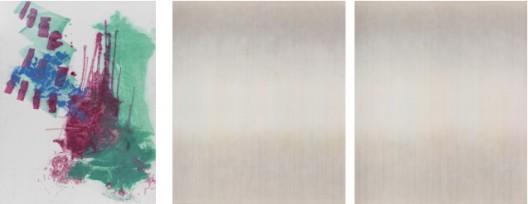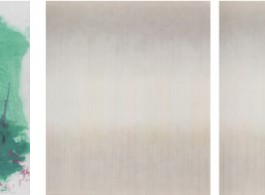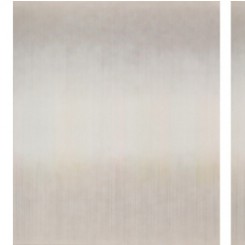Shanghai—Pearl Lam Galleries is pleased to present Theatre of Paper, a group exhibition that showcases a prime selection of painting, installation, and video works by six Chinese contemporary artists: Ni Haifeng b. 1964, Qin Feng b. 1961, Qin Yufen b. 1954, Qiu Deshu b. 1948, Shen Chen b. 1955, and Lan Zhanghui b. 1959.

L–R: Qin Yufen b. 1954, In Search of Lost Time—East 3, 2015, Mineral pigment, ink, Xuan paper
250 x 195 cm (98 3/8 x 76 3/4 in.)
Shen Chen b. 1955, Untitled No. 11023-07 (diptych), 2007, Acrylic on canvas, 157.5 x 284.5 cm (62 x 112 in.)
As the earliest artists in China to experiment with abstract or conceptual art in the 1980s, living between two or more different cultures—either physically or spiritually—each artist has forged a unique language of art in the past three decades. In light of this, Theatre of Paper aims to reveal the subtlety and sensitivity of each individual artist’s practice in the indefinable and shifting transitions from one culture to another and vice versa. Rather than try to make generalised statements to frame these artists in overarching artistic theories, each artist should be seen as an individual working in his/her own personalised micro-theatre. This exhibition encourages audiences to look at each artist’s works on their own terms, both visually and intellectually. Each artist depicts his or her own reality with different possibilities in today’s globalised world, where tradition plays a vital role and is a key factor in encouraging dialogue between local and global parties in an unbiased way. Therefore, the micro-theatre of an artist can be imagined as a subversive micro-utopia that challenges the homogeneity of culture and hegemony of capitalism.
Invisible threads linking to Chinese ink painting tradition can be traced in the practice of artists such as Shen Chen. Referencing traditional painting technique, the artist says, “My works are composed of the most simple brushstrokes. Overlapping parts of strokes form black strips (yong bi), while the space between brushstrokes makes white lines (liu bai). I use both the entire brush and the corner of a brush.” Shen Chen achieves the state of freedom and transcendence as pursued in literati painting, but in a conceptual and time-condensed manner embodied in repetitive strokes.
Qin Yufen’s installation work Extension is an open scroll of Xuan paper (1.5 metres wide and 100 metres long) rolled on a wooden axis. At its centre is an electric wire in place of actual painted ink lines, which mediates between the artist’s traditions and her current state of being. Qin began to create abstract paintings in 1982 before she moved to Berlin and has been acknowledged internationally for her sound installations since the 1990s. The exhibition also presents Qin’s most recent series of ink paintings, In Search of Lost Time.
‘Fissuring’ hints at an evolutionary process resulting from the aggregation and disaggregation of energy. When Qiu Deshu discovered it in 1982 as a unique painting technique he has carried on with it relentlessly. It is his source of spiritual strength and represents his pursuit of independent spirit, technique, and style. Reinventing tradition from within, Qiu subverts the way ink and brush are defined in traditional Chinese landscape paintings by tearing up Xuan paper, re-configuring and remounting the pieces to create ‘fissures’ on top of a coloured base layer, combined with rubbing and carving multiple layers of paper. This contemporary rendering of landscapes is rooted in Qiu’s deep respect and love for the tradition, which he sees as his spiritual home. From this, Qiu has developed a new art language that stands on its own terms.
Invisible threads linking to Chinese ink painting tradition can be traced in the practice of artists such as Shen Chen. Referencing traditional painting technique, the artist says, “My works are composed of the most simple brushstrokes. Overlapping parts of strokes form black strips (yong bi), while the space between brushstrokes makes white lines (liu bai). I use both the entire brush and the corner of a brush.” Shen Chen achieves the state of freedom and transcendence as pursued in literati painting, but in a conceptual and time-condensed manner embodied in repetitive strokes.
Qin Yufen’s installation work Extension is an open scroll of Xuan paper (1.5 metres wide and 100 metres long) rolled on a wooden axis. At its centre is an electric wire in place of actual painted ink lines, which mediates between the artist’s traditions and her current state of being. Qin began to create abstract paintings in 1982 before she moved to Berlin and has been acknowledged internationally for her sound installations since the 1990s. The exhibition also presents Qin’s most recent series of ink paintings, In Search of Lost Time.
‘Fissuring’ hints at an evolutionary process resulting from the aggregation and disaggregation of energy. When Qiu Deshu discovered it in 1982 as a unique painting technique he has carried on with it relentlessly. It is his source of spiritual strength and represents his pursuit of independent spirit, technique, and style. Reinventing tradition from within, Qiu subverts the way ink and brush are defined in traditional Chinese landscape paintings by tearing up Xuan paper, re-configuring and remounting the pieces to create ‘fissures’ on top of a coloured base layer, combined with rubbing and carving multiple layers of paper. This contemporary rendering of landscapes is rooted in Qiu’s deep respect and love for the tradition, which he sees as his spiritual home. From this, Qiu has developed a new art language that stands on its own terms.
About Pearl Lam Galleries
Founded by Pearl Lam, Pearl Lam Galleries is a driving force within Asia’s contemporary art scene. With over 20 years of experience exhibiting Asian and Western art and design, it is one of the leading and most established contemporary art galleries to be launched out of China.
Playing a vital role in stimulating international dialogue on Chinese and Asian contemporary art, the Galleries is dedicated to championing artists who re-evaluate and challenge perceptions of cultural practice from the region. The Galleries in Hong Kong, Shanghai, and Singapore collaborate with renowned curators, each presenting distinct programming from major solo exhibitions, special projects, and installations to conceptually rigorous group shows. Based on the philosophy of Chinese Literati where art forms have no hierarchy, Pearl Lam Galleries is dedicated to breaking down boundaries between different disciplines, with a unique gallery model committed to encouraging cross-cultural exchange.
Contemporary Chinese Abstract art is heavily represented in the Galleries roster. Influential Chinese artists Zhu Jinshi and Su Xiaobai, who synthesise Chinese sensibilities with an international visual language, are presented internationally with work now included in major private and public collections worldwide. The Galleries has also introduced leading international artists such as Leonardo Drew, Jenny Holzer, Carlos Rolón/Dzine, and Yinka Shonibare MBE (RA) to markets in the region, providing opportunities for new audiences in Asia to encounter their work. Pearl Lam Galleries encourages international artists to create new work which engages specifically with the region, collaborating to produce thought-provoking, culturally relevant work.


